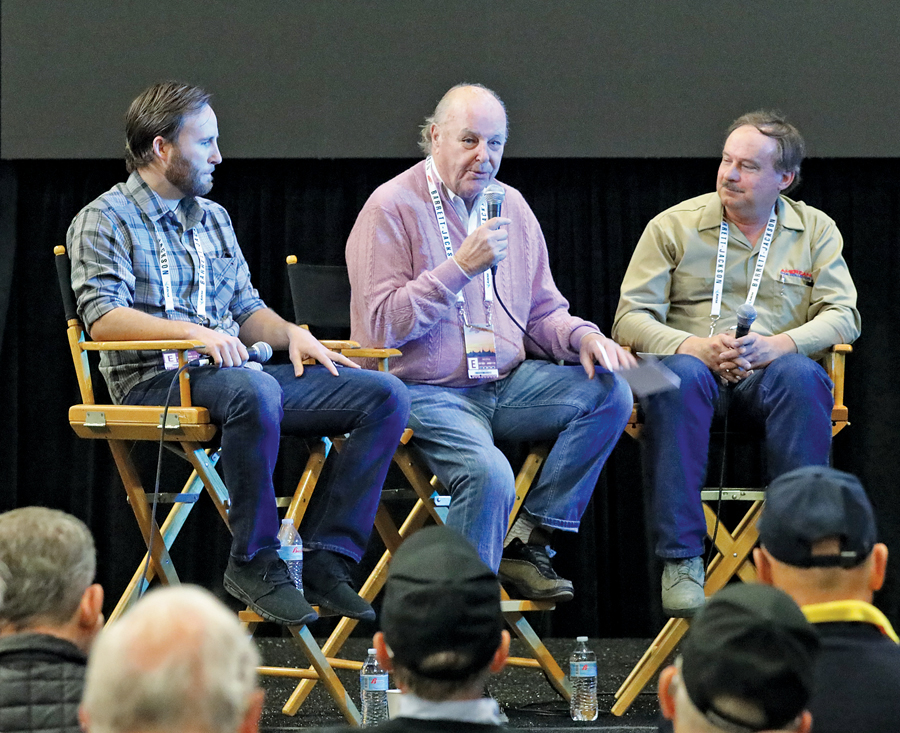
I was invited to participate in ACC’s Buyer’s Symposium at Barrett-Jackson’s Scottsdale sale this January, and I had such a great time last year that there was no way I was going to miss it. Editor Pickering recalled last year’s crew, which consisted of the two of us, Carl Bomstead, B. Mitchell Carlson and Sam Stockham. He also persuaded the legendary Ken Lingenfelter to join us as well.
When preparing myself for the trip, I found that although I was excited to meet Ken and reunite with the other guys, I was most looking forward to arguing with Carl. We’ve only met in person twice — on stage on both occasions — but our personal unfamiliarity did little to slow our willingness to publicly and vehemently disagree. Let the record show that arguing with Mr. Bomstead is great fun.
Carl and I both share a passion for collectible automobiles, but it might be a stretch to say we share much more than that. We were born at opposite corners of the country, and are separated in age by a generation. Carl likes to refer to me as the “smartass kid” despite the fact that I’ll be preparing to roll over the hill next year. He serves as a National Director for the Classic Car Club of America and has been a judge at the Pebble Beach Concours d’Elegance for at least two decades now. I once did a burnout that resulted in the fire department showing up at my work.
Carl and I like different cars for different reasons, which should come as no surprise, but holy smokes, are we ever painting two different pictures of the same vista.
During this year’s panel, there was one question in particular that we couldn’t help but ask of the other, and that question really got me thinking about the value of relativism when it comes to collectible automobiles.
Shades of gray
Relativism is broadly defined as the idea that views are relative to differences in perception and consideration, and that there is no universal, objective truth. I’ve liked this idea as long as I’ve been mature enough to understand it, because it helps me make sense of all the arguments I’ve been in over the years.
As a young person, I saw the world very much in black and white. I had little capacity for acknowledging that the world is, in fact, rarely either.
Where I once believed an argument was either won or lost based on the merits of the argument itself, I’ve come to understand that even the best arguments rarely result in a swing of opinion. Rather, the strength of the argument can more accurately be measured by the willingness of the listener to accept that the arguer’s point might hold some validity. In other words, I don’t have to be wrong in order for you to be right.
Buy, sell, hold
To prepare for the symposium, Pickering had asked each of the participants to pick one car to buy, one car to hold, and one car to sell in the current market — and why. When my turn to speak about the car I chose to hold rolled around, Carl was not impressed.
I was advising listeners to hold resto-modded muscle cars for a number of reasons, which included falling sale prices, growing interest in later-model vehicles, and the overall influx of trucks and SUVs entering the market. My basic tenet was a simple one — because the steam driving the resto-mod market has cooled, why not drop the fear of depreciation and simply enjoy these vehicles as intended?
Carl looked me straight in the face with equal parts pity and disgust and said, “But what do you do with it?!”
I knew the question was coming and still I couldn’t help but laugh. For me, resto-modded muscle cars are about as perfect a blend of classic styling, performance and usability as a modern collector can ask for. They’re certainly not going to increase in value over time the way a numbers-matching car of the same skin will, but they’re a hell of a lot more fun.
I was attempting to make an argument for a class of cars that are some of the most user-friendly in all of American classics, and yet Carl was nearly beside himself because he rates collectibility and return on investment much differently than I do.
My favorite part of Carl’s argument against my pick was that he had chosen CCCA Full Classic V12 and V16 coupes to hold. Talk about “what do you do with it?” Those behemoths are snazzy parade queens, I’ll give them that, but I haven’t participated in a parade since a Shriner in a tiny car scolded me for riding wheelies on the Fourth of July when I was 10 years old. I can appreciate the styling and the influence, but if they’re not much for drag racing, burnouts or road trips, they’re not for me.
Gain some perspective
In my pick, Carl saw a mostly worthless class of cars influenced by a passing fad that have essentially been stripped of all that might have made them valuable — primarily their originality. In his pick, I saw a wholly unusable relic best kept under glass. In watching the crowd’s reaction to our words, I saw plenty of evidence that we were both right, and that neither of us was wrong.
Preparing for a conversation with Carl forces me to think about why I believe certain segments of the market perform the way they do, which in turn forces me to shore up my opinions with facts, evidence and perspective.
If you’re on the fence about which American collector cars to buy, hold, or sell, don’t waste your time on folks who already agree with you. Go find yourself a Carl. You’ll be better for it.